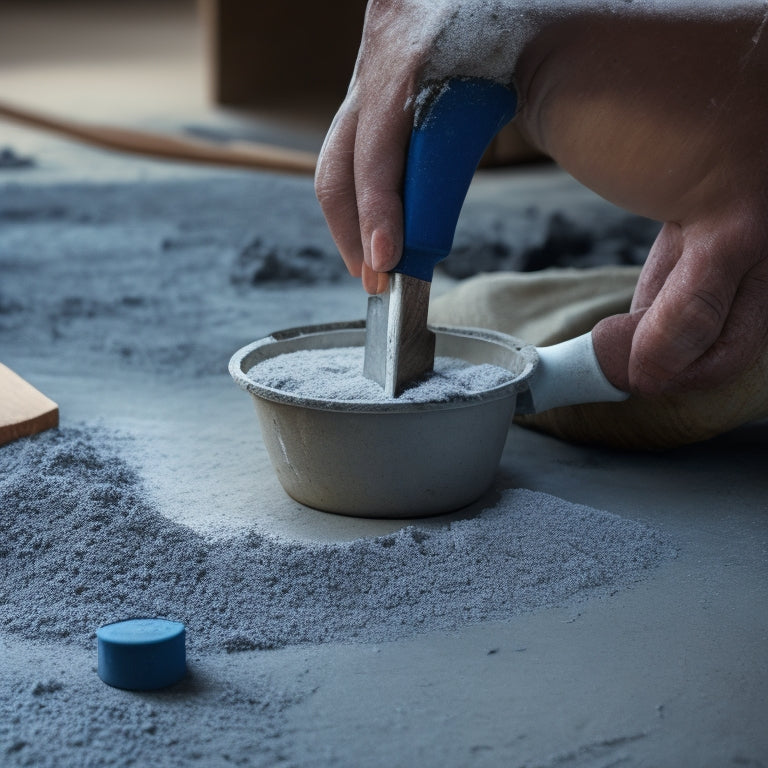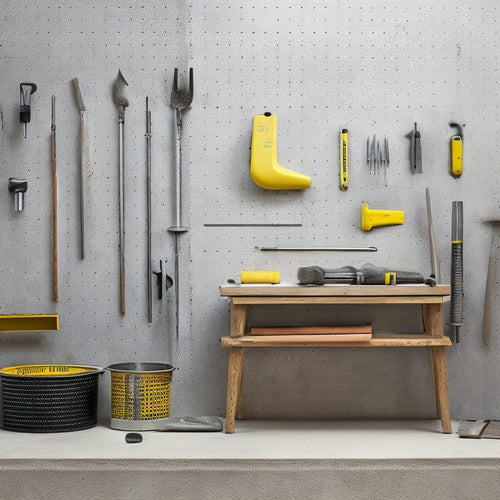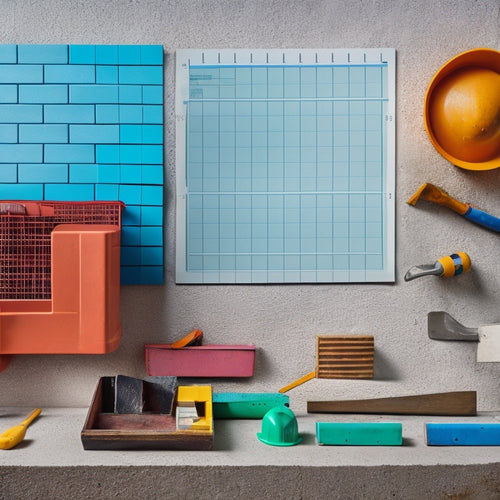
What Tools Ensure Concrete Adhesion Success
Share
You'll need a range of tools to guarantee concrete adhesion success. Begin with surface preparation tools like wire brushes, grinders, and shot blasters to create a rough surface and remove contaminants. Select the right primer and cleaner for your project, and choose a bonding agent that meets your specific needs. Properly meter and mix adhesives, and use applicator and finishing tools like trowels and brushes to achieve uniform coverage. Additionally, select the right cement and epoxy for your project, and prepare your substrate carefully. By mastering these tools and techniques, you'll be well on your way to achieving strong, long-lasting bonds - and there's more to explore to take your concrete adhesion skills to the next level.
Key Takeaways
- Surface preparation tools like wire brushes, grinders, and pressure washers ensure a clean and textured surface for optimal bonding.
- Primer and cleaner selection, such as epoxy primers and solvent cleaners, are critical for effective contaminant removal and bonding.
- Bonding agent characteristics like chemical resistance, flexibility, and cure time must align with project specifications for optimal performance.
- Adhesive metering and mixing techniques, including correct resin-to-hardener ratios and thorough mixing, are essential for achieving a strong bond.
- Applicator and finishing tools, such as high-quality trowels and finishing brushes, enable precise adhesive application and uniform coverage.
Essential Concrete Adhesion Tools
When it comes to ensuring a strong bond between concrete and its substrate, having the right tools for the job is essential.
You'll need to prepare the surface properly to prevent adhesion failure causes like weak bonding, delamination, and debonding. The surface texture significance can't be overstated, as it directly affects the bonding process.
You'll require a wire brush or a scrub brush to remove dirt, oil, and other contaminants that can compromise adhesion.
A grinder or a scarifier is necessary to create a rough texture, increasing the surface area for bonding. If you're dealing with a particularly stubborn substrate, a shot blaster may be needed to create a clean, rough surface.
Don't forget a vacuum cleaner or a blower to remove debris and dust from the prepared surface.
Primer and Cleaner Options
You'll need to select the right primer and cleaner for your specific concrete adhesion project to guarantee a strong bond. The primer you choose will depend on the type of concrete you're working with, as well as the environmental conditions it'll be exposed to.
Epoxy primers, for example, are ideal for high-traffic areas or areas subject to heavy wear and tear. They provide a strong, durable bond and are resistant to chemicals and abrasion.
When it comes to surface cleaners, you'll want to choose a product that effectively removes dirt, oil, and other contaminants without damaging the concrete. Look for a cleaner that's specifically designed for concrete surfaces and follow the manufacturer's instructions for application and dwell time.
A thorough cleaning is essential to ascertain a strong bond between the concrete and the adhesive or coating. By selecting the right primer and cleaner for your project, you'll be able to achieve a strong, long-lasting bond that will withstand the test of time.
Bonding Agent Selection Guide
With the right primer and cleaner in place, it's time to focus on selecting the ideal bonding agent for your concrete adhesion project. This critical component guarantees a strong, durable bond between the concrete and the overlay or coating.
When choosing a bonding agent, take into account the specific requirements of your project and the properties you need the agent to possess.
There are various bonding agent types, each with its unique characteristics. You'll want to take into account the following key factors:
-
Chemical resistance: Will the bonding agent be exposed to harsh chemicals or extreme temperatures?
-
Flexibility: Does the bonding agent need to accommodate movement or vibration?
-
Cure time: How quickly do you need the bonding agent to set and reach full strength?
Surface Preparation Tools Needed
Proper surface preparation is essential to achieving a strong, lasting bond between the concrete and the overlay or coating. To guarantee a successful bond, you'll need the right tools for the job.
When it comes to surface preparation, you'll want to focus on creating an ideal surface texture and removing any contaminants that might interfere with adhesion.
For surface texture modification, you'll need tools like scarifiers, grinders, or shot blasters. These tools will help you achieve the best surface texture for bonding, which is typically a rough, porous surface.
Scarifiers, for example, use rotating cutters to remove old coatings and create a rough surface. Grinders, on the other hand, use abrasive discs to smooth out the surface and create a more even texture.
For contamination removal, you'll need tools like pressure washers, scrub brushes, or solvent cleaners. These tools will help you remove dirt, oil, or other substances that might prevent the overlay or coating from bonding properly to the concrete.
Adhesive Metering and Mixing
After preparing the surface, it's crucial to accurately meter and mix the adhesive to guarantee a strong bond.
You must verify the adhesive properties are maximized for the specific application, taking into account factors like temperature, humidity, and substrate type.
To achieve this, follow these critical mixing techniques:
-
Ratio control: Confirm the correct ratio of resin to hardener is maintained to achieve the ideal adhesive properties.
-
Thorough mixing: Mix the adhesive components thoroughly, using a mixing technique that minimizes air entrapment and guarantees a homogeneous blend.
-
Temperature control: Mix the adhesive at the recommended temperature range to prevent premature curing or degradation of the adhesive properties.
Applicator and Finishing Tools
You've mixed the adhesive to perfection; now it's time to apply it and finish the job. As you move on to the application phase, the right tools will guarantee a successful bond between the concrete and the adhesive.
A high-quality trowel is essential for achieving the best thickness and coverage. Mastering various trowel techniques, such as holding the trowel at a 45-degree angle and applying gentle to moderate pressure, will help you achieve a uniform layer.
For smaller, intricate areas, finishing brushes come into play. These specialized brushes are designed to reach tight spaces and corners, allowing for precise application and minimizing excess adhesive.
When choosing finishing brushes, look for those with stiff bristles and an ergonomic handle, providing maximum control and comfort.
Cement and Epoxy Choices
Your cement and epoxy choices play a critical role in the success of your concrete bonding project, as they directly impact the strength and durability of the bond.
When selecting cement, you'll want to take into account the type that best suits your project's requirements. There are three key factors to keep in mind:
-
Cement types: Ordinary Portland cement (OPC) is a common choice, but you may also take into account rapid-hardening cement, low-heat cement, or sulfate-resistant cement, depending on your specific needs.
-
Epoxy properties: The epoxy you choose should possess the necessary properties to guarantee a strong bond, such as high tensile strength, excellent adhesion, and resistance to chemicals and UV light.
-
Compatibility: Verify that your chosen cement and epoxy are compatible with each other and with the substrate material to avoid any potential bonding issues.
Substrate Preparation Checklist
Ideal bonding performance hinges on a meticulously prepared substrate, where every imperfection or contaminant can compromise the integrity of the bond.
You must verify the substrate is free from surface contaminants, such as dirt, oil, or old adhesives, which can greatly reduce adhesion. Check the moisture levels, as excess moisture can lead to adhesive failure.
Temperature effects also play a vital role, and you should consider the ideal temperature range for the specific substrate and adhesive.
Different substrate types require unique preparation methods, so it's important to identify the substrate type and tailor your preparation accordingly.
Timing is critical, as applying the adhesive at the wrong time can lead to poor adhesion.
Consider environmental considerations, such as humidity and wind, which can impact the bonding process.
If necessary, implement repair techniques to address any substrate imperfections.
Quality Control and Testing
Its bond integrity relies on rigorous quality control and testing measures to assure the substrate-adhesive interface meets the expected standards.
You must ascertain that the substrate and adhesive are compatible, and the application process is flawless. Any deviation from the recommended procedures can lead to adhesion failure, resulting in costly repairs and rework.
To mitigate this risk, you should implement the following quality control and testing measures:
-
Adhesion testing: Conduct pull-off tests, peel tests, or shear tests to evaluate the bond strength between the substrate and adhesive.
-
Visual inspection: Perform regular visual checks to identify any signs of adhesion failure, such as cracks, blisters, or delamination.
-
Adhesion failure analysis: Conduct a thorough analysis of failed bonds to determine the root cause and implement corrective actions to prevent future failures.
Frequently Asked Questions
How Do I Handle Concrete Adhesion in Extreme Weather Conditions?
When you're working with concrete in extreme weather, you'll need to carefully manage temperature effects and moisture control to guarantee adhesion success; you'll want to monitor and adjust for temperature fluctuations and humidity levels to prevent bonding issues.
What Are the Safety Precautions for Working With Bonding Agents?
You're 5 times more likely to experience skin irritation when handling bonding agents without proper protection. When working with these agents, you must wear safety gear like gloves, goggles, and respirators to prevent skin and respiratory issues.
Can I Use Concrete Adhesives on Painted or Coated Surfaces?
You'll need to carefully select adhesive types and guarantee proper surface preparation when applying concrete adhesives to painted or coated surfaces, as some may not bond well or require specialized primers for ideal adhesion.
How Do I Troubleshoot and Fix Adhesion Failures?
When adhesion fails, you'll identify the root cause by examining surface preparation and bonding techniques, then re-apply concrete adhesives after correcting imperfections, ensuring a strong bond by following manufacturer guidelines and conducting thorough quality control checks.
What Are the Environmental Implications of Concrete Adhesives?
As you navigate the complex landscape of concrete adhesives, you'll find that sustainable materials and stringent environmental regulations are the double-edged sword that cuts both ways, balancing innovation with eco-friendliness.
Conclusion
By following the systematic sequence of surface preparation, primer and bonding agent selection, and meticulous mixing and application, you've masterfully mitigated the risks of concrete adhesion failure. Now, confidently carry out your construction project, knowing that your concrete creation will cling tenaciously to its substrate, thanks to these tried-and-true tools and techniques that guarantee a sturdy, long-lasting bond.
Related Posts
-

10 Must-Have Tools for Concrete Repair Organization
You'll need a solid organization system to keep your concrete repair tools and materials within easy reach, protected...
-

Reinforcement Tools Checklist for Concrete Block Walls
You'll need a range of reinforcement materials, including horizontal and vertical rebar, fiber mesh, and anchor bolts...
-

Top Mixing Tools for DIY Concrete Block Laying
When it comes to DIY concrete block laying, the right mixing tools are vital for a strong and durable structure. You'...


